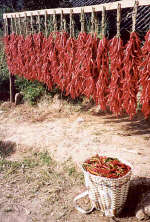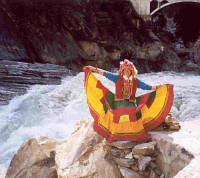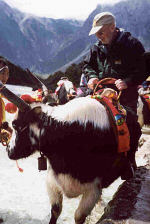Beyond Lijiang
Mr. Zhang, our driver, told us he preferred Zhondian over Lijiang. I asked him why, “Because Zhondian is hometown!” Unlike Norman, who was slender and fine-boned, Mr. Zhang stood solid and broad-shouldered, his face nicely bronzed from the mountain sun. He tried out his English on us hesitantly, but preferred to listen and absorb the barrage of questions that Norman deflected: “How long, how far, and are we almost there?”


Enroute to Zhondian
![]()
![]()
![]()
![]()
During our 125-mile ride to Zhondian, we’d stop at Tiger Leaping Gorge where the Yangzte River churns and thrashes its way into a narrow knot, cutting 10,000 feet into the mountainous landscape which culminates in the Mei Li Snow Mountains.
Apparently, this route had been opened only in recent years to foreign travelers. At Zhondian, a visit to the 323-year-old Songzanlin Monastery, the largest Tibetan Buddhist monastery in Yunnan Province and an evening in a local Tibetan family’s home were two reasons for choosing this town for an overnight stay. From Zhondian, we’d be driving over 16,000 foot passes to reach Deqen, the last big town before reaching the Tibetan Autonomous Region.
Lijiang ushered us out of town along its tree-lined paved boulevard as if she were gently reminding us not to forget the comfort of asphalt streets and city living. In spite of Lijiang’s charms, I was eager to explore the countryside.
Soon our winding road took us through farm villages. The results of a good harvest, several varieties of squash gourds were tucked underneath the eaves of large wood-beamed farmhouses. Norman told us these family homes were passed down from generation to generation and normally grandparents, parents and children lived under the same roof. (This came as a big surprise because I had been under the false impression that family homesteads no longer existed under communism.)


Red Peppers
![]()
![]()
![]()
![]()
Bright red chili peppers hung from the walls or on special stands where they dried in the November sun. Our route took us constantly upward past terraced land and cloud-swathed panoramas of golden-tinged fir trees. In the distance we spotted the broad band of the Yangtze River glinting like an unsheathed sword.
As we drew closer to Tiger Leaping Gorge Park, the road twisted in tighter hairpin curls as if it were feeling the squeeze of the mountain’s fist, streams of water trickling and pulling at its underpinnings. Stray rocks littered the pavement. Some had been painted red to caution drivers. At other points, mouth-bite gouges chewed away at the road’s edge leaving a gaping glimpse of the unforgiving gorge.
Tour buses jostled past us. Chris wanted to know if Mr. Zhang had switched to four-wheel drive yet. “Don’t ask,” I said, “We’ve asked too many questions. Anyhow, ignorance is bliss.”
Yinjie had warned us that the roads would be rough. However, army roadwork crews appeared to be working diligently to build a safe route from Lijiang to Zhondian. Never were we stopped or asked to show identification (unlike India where the driver’s papers needed to be inspected, and inevitably fined).
At Tiger Leaping Gorge, 520 steps lead to the point where a mythical tiger once leaped from bank to bank. We chose to walk down the steps past numerous trinket stands strategically erected near resting spots. Other visitors opted to be carried down or up the steps “emperor style” by a team of two sure-footed men carrying a wooden sedan.


Young model at Tiger Leaping Gorge
![]()
![]()
Far below, the Yangtze rollicked and somersaulted in a hurdy gurdy torrent of froth. Equally impressive were the soaring tree-lined mountain tops hovering above us like linebackers. Kids decked out in ethnic dress posed on rocks framed by the rushing river, two fingers held up to request two yuan for a photo. (For two yuan, we could order tasty steamed breakfast buns in Deqen!)
Back in Qiaotou, the town closest to Tiger Leaping Gorge, the weekly market was drawing to a close as Yi women in their flat-brimmed hats gracefully negotiated the crowd, chatting with neighbors along the way. We pulled up to a roadside restaurant for soup and noodles. I was happy that Mr. Zhang and Norman ate lunch with us. Unlike more formal group tours where guides eat separately, we could enjoy the pleasure of sharing a meal together.
When we took to the road again, shafts of sunlight illuminated the green and golden leaves. The beauty of this region is totally unlike the eerie mountain formations of Guilin or the tranquil expanses one views passing the Three Gorges during a Yangtze River cruise.
The mountain spirit scooped us up and tossed us into a mossy pocket of forestland, but as we gained altitude, the topography flattened, the velvet-gloved undulation of the wilderness ceded to vast expanses of farmland. A golden plateau stretched ahead of us dotted with yaks, pigs and goats. Everywhere there were signs of preparation for winter, more corn hung to dry and racks of barley and hay. Our jeep progressed quickly as the road into town smoothed out.


Chris on a yak
![]()
![]()
![]()
![]()
Zhondian, like Lhasa, had a frontier-town edginess – like a kid too big for his britches. Row upon row of cinder block garage shops flanked wide avenues still under construction. Cyclists wore face masks to avoid inhaling dust. It wasn’t a pretty town and turned its back on the mountain ranges, but once we’d dropped our bags at the flossy Pacific Rim Hotel and ventured out onto one of the main streets, Zhondian’s energy made us forget its gangly growing pains.
For a town population of 40,000, (80,000 if you include the surrounding villages), the variety of shops and merchandise was impressive. We passed solar energy panel stores, several furniture wholesalers, trendy hair salons, grocery stores selling 7-11 style snacks with a twist: Dried yak meat rather than beef jerky. Plus, skin care products, shampoos and soaps. During a walk, we bumped into a Dutch couple who told us they were traveling with a group of sixteen.
Back at the hotel, I read (in China Magazine) that at least one American English teacher and his family lived in town. In the hotel restaurant, we compared travel notes with a group of Chinese-Americans taking a similar route to ours. One Los Angeles-based family tried to visit different regions of China each year. The husband parted with this advice: “If you really want to see Shangri-la, you’ve got to go to Szechuan province.”
I dutifully jotted down the name of the county in Szechuan. “Next trip!” I said cheerfully, thinking to myself, “We’ve only just begun what appears to be a life-long wild goose chase.”